It is 1958 and a young man sits nonchalantly on his first motorcycle. A 1956 BSA Bantam 150cc, I bought after a bad and financially costly experience with an ancient 1934 Ford 8 when learners were allowed to drive unaccompanied due to the Suez Crisis. My mother had said, "Don't buy a motorcycle, get a little car, they're safer". But it was hell on a National Service squaddie's meagre pocket.
At this time I was doing army service and went to the local dealers with a knowledgeable mate to choose. I bought it and the next week went with the same mate to get it. We rode back to barracks through Canterbury with him on the back shouting instructions. I had never ridden before, but youth has confidence. Training and crash helmets were not yet compulsory, so hearing was easy.
It was such a pleasant revelation that I rode it 30 miles to Maidstone that very evening to see my girlfriend. A lifetime's love and devotion were formed (with motorcycles and Margaret, the said girlfriend, who would become my wife for over 63 years and until she died recently). Here she sits astride the little bike:
she too was to get the bug and loved being on the back, subsequently owning her own machines for a number of years until rheumatoid arthritis put paid to it.
Mike and Margaret on way home to Kent from watching the Banbury Run.
Came marriage and eventually children started to arrive. With two, we invested in a sporty looking sidecar combination
Really it gave the impression of a bishop arm in arm with a tart (thank you Roy K Battson) as the bike was a rather staid BSA 600cc sidevalve attached to the sports Garrard Grand Prix child/adult chair. Nevertheless our first holiday was spent touring Devon and Cornwall, wife with very young son on her lap in front and 4 year old daughter in the back secured to the sides of the chair with baby reins. Here we are crossing Exmoor on a "moist" day.(Note the pushchair, carried for said son)
As the family increased with another son, so we went up the combination chain until the chairs began to look like small buses.
BSA M21 sidevalve 600 with Busmar Astral double adult chair.
Another Squariel with later Canterbury Carmobile - I preferred the earlier version.
Eventually the kids became interested in rides on the pillion of my 200cc LE Velocette but the boys never really took to it
Only my daughter, taking after her mother and loving it so much that she eventually trained and rode on her own moped.
She now rides a Royal Enfield Bullet 500 in Western Australia!
We got a car, but I always had a motorcycle in the garage. My love for big single Royal Enfield Bullets started about now in 1965
Then, in the '70s I deserted to East European two-strokes, the Jawa 350 twin and MZ 250 being favourites
Numerous SJF s (standard Japanese fours) followed, particularly the gorgeous Honda 400F which was my first Jap bike and a sweet revelation.
However in the '80s I began an enthusiasm for BMW flat twins. My second, a 1000c model R100 I kept for over 27 years, only reluctantly selling it in 2012 as arthritis began to make moving it around painful
So it was back to a first love Royal Enfield Bullets, only now made in India, but having an updated fuel injected engine
I had hoped that this would see me through to my dotage, but a couple of strokes left me with reduced use of my left arm and leg. Motorcycling was impossible for a few months, but as soon as possible I managed to get back on two wheels with a "twist and go" Honda 125cc scooter which has no left hand clutch or left foot gear change to operate
I might hang on to this as it is so useful and easy to ride (and who knows what the future will hold), but it is not the same as motor cycling. On a scooter one sits primly upright, knees together, rather like a spinster at a vicarage tea party. My view of motorcycling is described by this https://little-corner-of-the-earth.blogspot.com/2006/10/wiltshire-ride.html
But even the Enfield became too heavy for me to push around when off it, particularly backwards due to poor balance (only off the bike thankfully) and lack of muscle tone, so I invested in a "tiddler" - only 114 kgs. A Honda CG125, owned by a mature rider who sold it to another one (me)
As my health regained a bit I managed to go up the scale a little to classic 250cc Jap bikes, the last being a rather nice Suzuki TU250X
But eventually I was led to the AJS Tempest Roadster. A lightweight 125cc with low seat height and electric foot (essential) Yes, it is basically a Chinese made bike but specially finished for the English AJS concern, looks super in black and gold and nostalgically reminds me of the 500cc Ajay single I had in the early 1960s.
An old motorcyclist, John Masterman once said,
"Cut your miles a day down from 300 to 200, and 200 to 100 or even less.
Ride and rest - and ride again. Never give it up. Never say die.
Never part from an interest and love that is life itself."
I may have posted this link before , but make no apologies - worth a view.

























